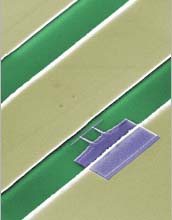|

Press Release 04-113
Physicists Create Artificial Molecule On A Chip


In circuit QED experiments, a photon trapped between the transmission lines (tan) couples to the ...
Credit and Larger Version |
September 8, 2004
Using integrated circuit fabrication techniques, a team of researchers from Yale University has bound a single photon to a superconducting device engineered to behave like a single atom, forming an artificial molecule. It’s the first experimental result in a field Yale professors Robert Schoelkopf and Steven Girvin have dubbed Circuit Quantum Electrodynamics.
The superconducting devices can be operated as qubits, the basic element of information storage in the field of quantum computing. In the September 9th issue of the journal Nature, Andreas Wallraff and his colleagues present telltale evidence that their qubit was coupling to a microwave photon, sharing energy in much the same way electrons are shared when two atoms combine to form a molecule. They offered two suggestions for naming the new, combined state: phobit or quton.
Qutons have been made before, the first about 12 years ago. But by using artificial atoms for their qubits instead of real ones, and microwave transmission lines instead of optical cavities, the Yale physicists were able to shrink a roomful of experimental apparatus onto a chip less than 1 square centimeter (or less than ¼ square inch) in size. They have also improved the coupling between resonator and “atom” by a factor of about 1000, which will help them explore fundamental interactions of light and matter. Soon they will try to control several qubits on one chip, using photons to connect them together in a prototype architecture for quantum computing and quantum cryptography.
-NSF-

Media Contacts
Philip Lippel, NSF (703) 292-7741 plippel@nsf.gov
Janet Emanuel, Yale University (203) 432-2157 janet.emanuel@yale.edu
Program Contacts
Hollis Wickman, NSF (703) 292-4929 hwickman@nsf.gov
Principal Investigators
Steven Girvin, Yale University (203) 432-5082 steven.girvin@yale.edu
Robert Schoelkopf, Yale University (203) 432-4289 rob.schoelkopf@yale.edu
Related Websites
Yale Circuit QED website: http://www.eng.yale.edu/rslab/cQED
Yale University Press Release: http://www.eurekalert.org/emb_releases/2004-09/yu-ysb090604.php

The National Science Foundation (NSF) is an independent federal agency that
supports fundamental research and education across all fields of science and
engineering, with an annual budget of $6.06 billion. NSF funds reach all 50
states through grants to over 1,900 universities and institutions. Each year,
NSF receives about 45,000 competitive requests for funding, and makes over
11,500 new funding awards. NSF also awards over $400 million in
professional and service contracts yearly.
 Get News Updates by Email Get News Updates by Email
Useful NSF Web Sites:
NSF Home Page: http://www.nsf.gov
NSF News: http://www.nsf.gov/news/
For the News Media: http://www.nsf.gov/news/newsroom.jsp
Science and Engineering Statistics: http://www.nsf.gov/statistics/
Awards Searches: http://www.nsf.gov/awardsearch/
| 


